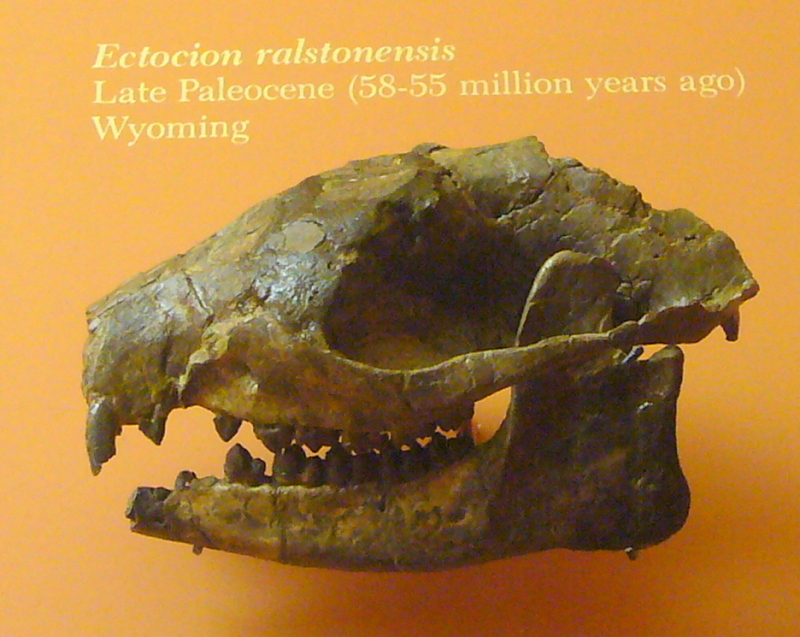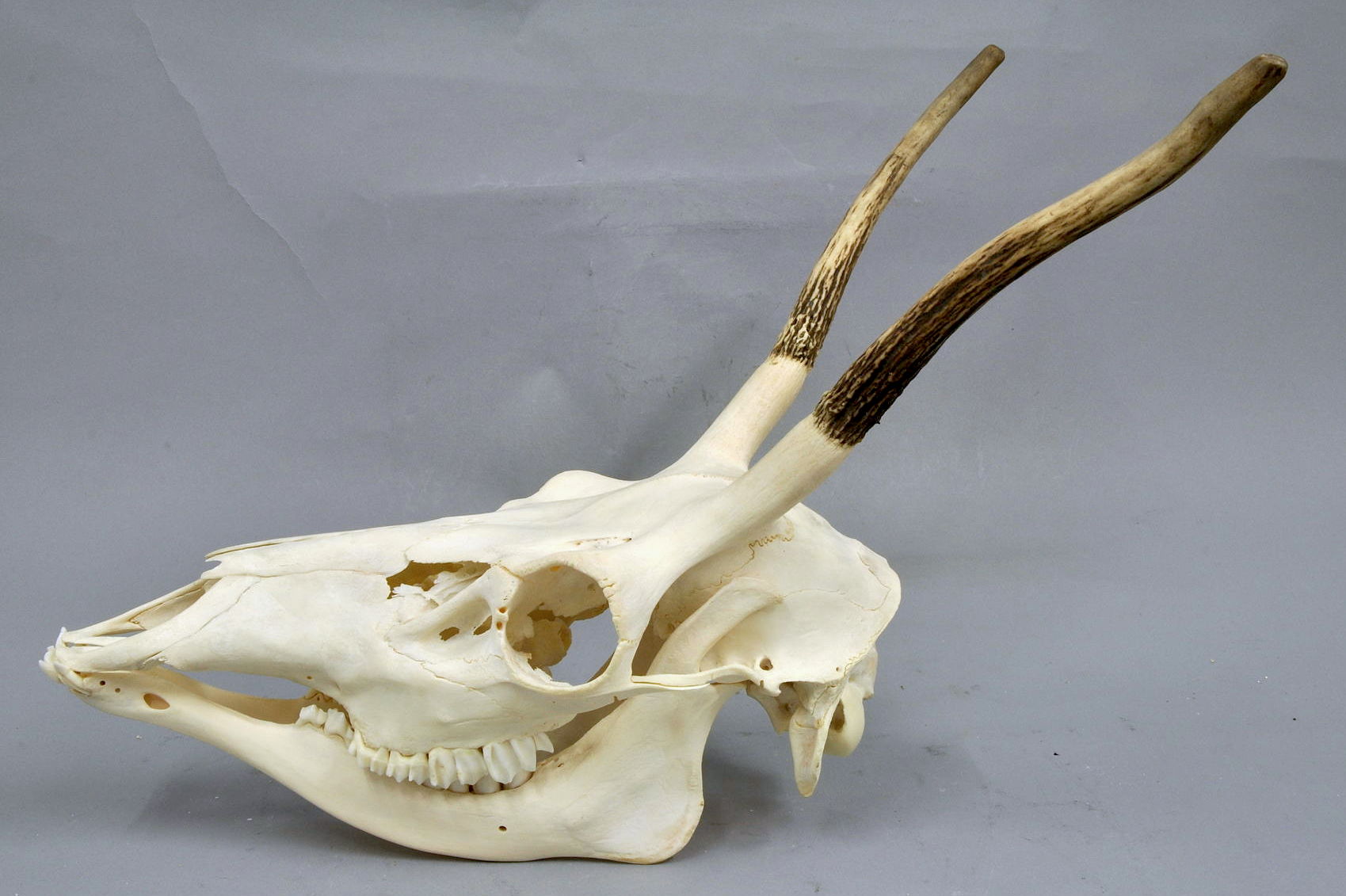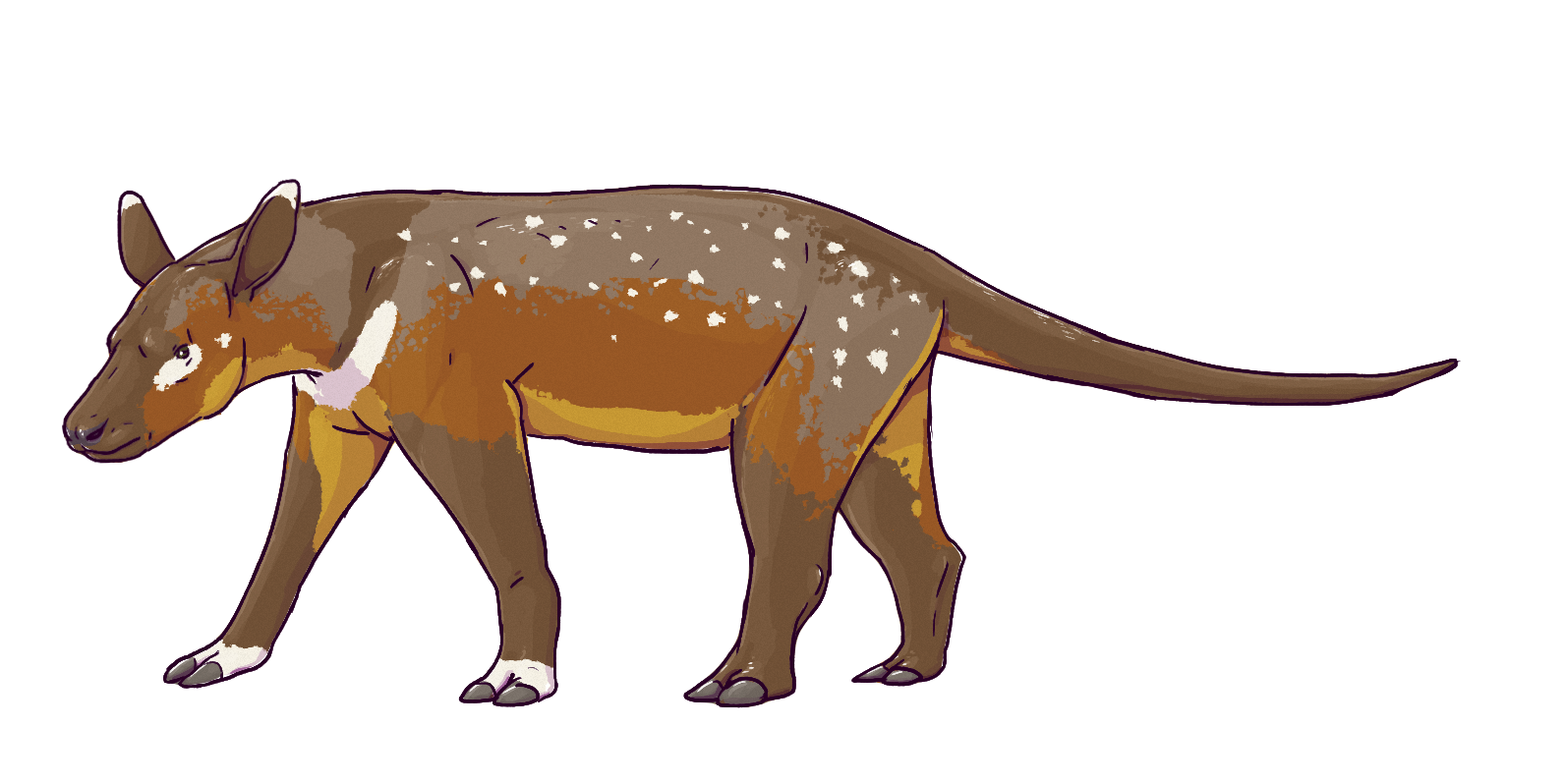|
Ungulates
Ungulates ( ) are members of the diverse clade Euungulata ("true ungulates"), which primarily consists of large mammals with hooves. Once part of the clade "Ungulata" along with the clade Paenungulata, "Ungulata" has since been determined to be a polyphyletic and thereby invalid clade based on molecular data. As a result, true ungulates had since been reclassified to the newer clade Euungulata in 2001 within the clade Laurasiatheria while Paenungulata has been reclassified to a distant clade Afrotheria. Living ungulates are divided into two orders: Perissodactyla including equines, rhinoceroses, and tapirs; and Artiodactyla including cattle, antelope, pigs, giraffes, camels, sheep, deer, and hippopotamuses, among others. Cetaceans such as whales, dolphins, and porpoises are also classified as artiodactyls, although they do not have hooves. Most terrestrial ungulates use the hoofed tips of their toes to support their body weight while standing or moving. Two other orders o ... [...More Info...] [...Related Items...] OR: [Wikipedia] [Google] [Baidu] |
Phenacodontidae
Phenacodontidae is an extinct family of large herbivorous mammals traditionally placed in the “wastebasket taxon” Condylarthra, which may instead represent early-stage perissodactyls. They lived from the late early Paleocene to early middle Eocene (about 60–50 million years ago) and their fossil remains have been found in North America and Europe. The only unequivocal Asian phenacodontid is '' Lophocion asiaticus''. Description These animals had a variety of body sizes, and could be as small as domestic cats ('' Tetraclaenodon'' and '' Ectocion'') and as large as sheep ('' Phenacodus''). The skull of phenacodontids is long and narrow, and equipped with a small braincase. The skeleton of phenacodontids show several primitive characteristics (the long and heavy tail for example) but also a number of advanced, Perissodactyla-like adaptations: Their long legs, for example, had five fingers, but the first finger showed a clear reduction, and in some forms (like ''Phenacod ... [...More Info...] [...Related Items...] OR: [Wikipedia] [Google] [Baidu] |
Wild Boar
The wild boar (''Sus scrofa''), also known as the wild swine, common wild pig, Eurasian wild pig, or simply wild pig, is a Suidae, suid native to much of Eurasia and North Africa, and has been introduced to the Americas and Oceania. The species is now one of the widest-ranging mammals in the world, as well as the most widespread Suina, suiform. It has been assessed as least concern on the IUCN Red List due to its wide range, high numbers, and adaptability to a diversity of habitats. It has become an invasive species in part of its introduced range. Wild boars probably originated in Southeast Asia during the Early Pleistocene and outcompeted other suid species as they spread throughout the Old World. , up to 16 subspecies are recognized, which are divided into four regional groupings based on skull height and lacrimal bone length. The species lives in matriarchal societies consisting of interrelated females and their young (both male and female). Fully grown males are usually s ... [...More Info...] [...Related Items...] OR: [Wikipedia] [Google] [Baidu] |
Panperissodactyla
Panperissodactyla ("all perissodactyls", alternatively spelled Pan-Perissodactyla) is a clade of ungulates containing living order Perissodactyla (odd-toed ungulates) and all extinct ungulates more closely related to Perissodactyla than to Artiodactyla (even-toed ungulates). Groups thought to belong to this clade include Anthracobunia (including the families Anthracobunidae and Cambaytheriidae) known from the Paleogene of the Indian subcontinent, as well as the South American native ungulate groups Litopterna and Notoungulata, both of which went extinct approximately 12,000 years ago. Other South American native ungulate groups also possibly belong to the clade, but their placement is uncertain. The enigmatic aquatic Desmostylia have also been suggested to be related to perissodactyls in some studies, though others recover them as members of afrotherian clade Tethytheria. The Northern Hemisphere "condylarth" group Phenacodontidae has been placed as closely related to perissodac ... [...More Info...] [...Related Items...] OR: [Wikipedia] [Google] [Baidu] |
Notoungulata
Notoungulata is an extinct order of ungulates that inhabited South America from the early Paleocene to the end of the Pleistocene, living from approximately 61 million to 11,000 years ago. Notoungulates were morphologically diverse, with forms resembling animals as disparate as rabbits and rhinoceroses. Notoungulata are the largest group of South American native ungulates, with over 150 genera in 14 families having been described, divided into two major subgroupings, Typotheria and Toxodontia. Notoungulates first diversified during the Eocene. Their diversity declined from the late Neogene onwards, with only the large Toxodontidae, toxodontids persisting until the end of the Pleistocene (with ''Mixotoxodon'' expanding into Central America and southern North America), perishing as part of the Late Pleistocene extinctions, Late Pleistocene megafauna extinctions along with most other large mammals across the Americas. Collagen sequence analysis suggests that notoungulates are closely ... [...More Info...] [...Related Items...] OR: [Wikipedia] [Google] [Baidu] |
Giraffe
The giraffe is a large Fauna of Africa, African even-toed ungulate, hoofed mammal belonging to the genus ''Giraffa.'' It is the Largest mammals#Even-toed Ungulates (Artiodactyla), tallest living terrestrial animal and the largest ruminant on Earth. It is classified under the Family (biology), family Giraffidae, along with its closest extant relative, the okapi. Traditionally, giraffes have been thought of as one species, ''Giraffa camelopardalis'', with nine subspecies. Most recently, researchers proposed dividing them into four Neontology#Extant taxa versus extinct taxa, extant species which can be distinguished by their fur Animal coat, coat patterns. Six valid Lists of extinct species, extinct species of ''Giraffa'' are known from the fossil record. The giraffe's distinguishing characteristics are its extremely long neck and legs, horn-like ossicones, and spotted coat patterns. Its scattered range extends from Chad in the north to South Africa in the south and from Niger in ... [...More Info...] [...Related Items...] OR: [Wikipedia] [Google] [Baidu] |
Litopterna
Litopterna (from "smooth heel") is an extinction, extinct order of South American native ungulates that lived from the Paleocene to the Pleistocene-Holocene around 62.5 million to 12,000 years ago (or possibly as late as 3,500 years ago), and were also present in Antarctica during the Eocene. They represent the second most diverse group of South American ungulates after Notoungulata. It is divided into nine families, with Proterotheriidae and Macraucheniidae being the most diverse and last surviving families. Diversity The body forms of many litopterns, notably in the limb and skull structure, are broadly similar to those of living ungulates, unlike other South American native ungulate groups, which are often strongly divergent from living ungulates. Paleocene and Eocene litopterns generally had small body masses, with ''Protolipterna'' (Protolipternidae) estimated to have had a body mass of , though the Eocene Sparnotheriodontidae, sparnotheriodontids were considerably large ... [...More Info...] [...Related Items...] OR: [Wikipedia] [Google] [Baidu] |
Artiodactyls
Artiodactyls are placental mammals belonging to the order Artiodactyla ( , ). Typically, they are ungulates which bear weight equally on two (an even number) of their five toes (the third and fourth, often in the form of a hoof). The other three toes are either present, absent, vestigial, or pointing posteriorly. By contrast, most perissodactyls bear weight on an odd number of the five toes. Another difference between the two orders is that many artiodactyls (except for Suina) digest plant cellulose in one or more stomach chambers rather than in their intestine (as perissodactyls do). Molecular biology, along with new fossil discoveries, has found that cetaceans (whales, dolphins, and porpoises) fall within this taxonomic branch, being most closely related to hippopotamuses. Some modern taxonomists thus apply the name Cetartiodactyla () to this group, while others opt to include cetaceans within the existing name of Artiodactyla. Some researchers use "even-toed ungulates" to excl ... [...More Info...] [...Related Items...] OR: [Wikipedia] [Google] [Baidu] |
Red Deer
The red deer (''Cervus elaphus'') is one of the largest deer species. A male red deer is called a stag or Hart (deer), hart, and a female is called a doe or hind. The red deer inhabits most of Europe, the Caucasus Mountains region, Anatolia, Iran, and parts of western Asia. It also inhabits the Atlas Mountains of Northern Africa, being the only living species of deer to inhabit Africa. Red deer have been introduced to other areas, including Australia, New Zealand, the United States, Canada, Peru, Uruguay, Chile and Argentina. In many parts of the world, the meat (venison) from red deer is used as a food source. The red deer is a ruminant, characterized by a four-chambered stomach. Genetics, Genetic evidence indicates that the red deer, as traditionally defined, is a species group, rather than a single species, though exactly how many species the group includes remains disputed. The ancestor of the red deer probably originated in central Asia. Although at one time red deer were ... [...More Info...] [...Related Items...] OR: [Wikipedia] [Google] [Baidu] |
Anthracobunia
Panperissodactyla ("all perissodactyls", alternatively spelled Pan-Perissodactyla) is a clade of ungulates containing living order Perissodactyla (odd-toed ungulates) and all extinct ungulates more closely related to Perissodactyla than to Artiodactyla (even-toed ungulates). Groups thought to belong to this clade include Anthracobunia (including the families Anthracobunidae and Cambaytheriidae) known from the Paleogene of the Indian subcontinent, as well as the South American native ungulate groups Litopterna and Notoungulata, both of which went extinct approximately 12,000 years ago. Other South American native ungulate groups also possibly belong to the clade, but their placement is uncertain. The enigmatic aquatic Desmostylia have also been suggested to be related to perissodactyls in some studies, though others recover them as members of afrotherian clade Tethytheria. The Northern Hemisphere "condylarth" group Phenacodontidae has been placed as closely related to perissodac ... [...More Info...] [...Related Items...] OR: [Wikipedia] [Google] [Baidu] |
Hoof
The hoof (: hooves) is the tip of a toe of an ungulate mammal, which is covered and strengthened with a thick and horny keratin covering. Artiodactyls are even-toed ungulates, species whose feet have an even number of digits; the ruminants with two digits are the most numerous, e.g. giraffe, deer, bison, cattle, goats, gazelles, pigs, and sheep. The feet of perissodactyl mammals have an odd number of toes, e.g. the horse, the rhinoceros, and the tapir. Although hooves are limb structures primarily found in placental mammals, hadrosaurs such as '' Edmontosaurus'' possessed hoofed forelimbs. The marsupial '' Chaeropus'' also had hooves. Description The hoof surrounds the distal end of the second phalanx, the distal phalanx, and the navicular bone. The hoof consists of the hoof wall, the bars of the hoof, the sole and frog and soft tissue shock absorption structures. The weight of the animal is normally borne by both the sole and the edge of the hoof wall. Hooves perform man ... [...More Info...] [...Related Items...] OR: [Wikipedia] [Google] [Baidu] |
Artiodactyla
Artiodactyls are placental mammals belonging to the order (biology), order Artiodactyla ( , ). Typically, they are ungulates which bear weight equally on two (an even number) of their five toes (the third and fourth, often in the form of a hoof). The other three toes are either present, absent, vestigial, or pointing posteriorly. By contrast, most perissodactyls bear weight on an odd number of the five toes. Another difference between the two orders is that many artiodactyls (except for Suina) digest plant cellulose in one or more stomach chambers rather than in their intestine (as perissodactyls do). Molecular biology, along with new fossil discoveries, has found that cetaceans (whales, dolphins, and porpoises) fall within this taxonomic branch, being most closely related to Hippopotamidae, hippopotamuses. Some modern taxonomists thus apply the name Cetartiodactyla () to this group, while others opt to include cetaceans within the existing name of Artiodactyla. Some researchers ... [...More Info...] [...Related Items...] OR: [Wikipedia] [Google] [Baidu] |
Even-toed Ungulate
Artiodactyls are placental mammals belonging to the order Artiodactyla ( , ). Typically, they are ungulates which bear weight equally on two (an even number) of their five toes (the third and fourth, often in the form of a hoof). The other three toes are either present, absent, vestigial, or pointing posteriorly. By contrast, most perissodactyls bear weight on an odd number of the five toes. Another difference between the two orders is that many artiodactyls (except for Suina) digest plant cellulose in one or more stomach chambers rather than in their intestine (as perissodactyls do). Molecular biology, along with new fossil discoveries, has found that cetaceans (whales, dolphins, and porpoises) fall within this taxonomic branch, being most closely related to hippopotamuses. Some modern taxonomists thus apply the name Cetartiodactyla () to this group, while others opt to include cetaceans within the existing name of Artiodactyla. Some researchers use "even-toed ungulates" to e ... [...More Info...] [...Related Items...] OR: [Wikipedia] [Google] [Baidu] |








